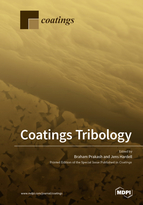Coatings Tribology
A special issue of Coatings (ISSN 2079-6412).
Deadline for manuscript submissions: closed (31 August 2018) | Viewed by 56328
Special Issue Editors
Interests: high temperature tribology; tribology of materials and lubricants; solid lubricants/self-lubricating coatings; boundary lubrication; tribology of machine components (bearings, gears, and seals); analysis and solution of wear related problems; tribotesting
Interests: high temperature tribology; friction and wear in dry contacts; tribomaterials; surface engineering for friction and wear control
Special Issues, Collections and Topics in MDPI journals
Special Issue Information
Dear Colleagues,
As you know, tribological coatings are increasingly used to control (mostly to minimize) friction, wear, and surface damage to moving machine components in various applications. The use of coatings, in addition to improving efficiency and durability of tribological systems, also enables to conserve strategic materials and minimize or eliminate the use of hazardous materials. This Special Issue focuses on the tribological coatings. The topics of interest for this this Special Issue, in particular, include (but are not restricted to):
- Novel (lubricious) coatings to control and minimize friction
- Coatings for wear control in general
- Tribological coatings for extreme operating conditions, e.g., for high/low temperatures, aggressive environments, etc.
- Friction and wear phenomena in tribological coatings
- Characterization of nano, micro, and macro friction and wear characterization of coatings under various operating conditions
- Any other aspects of tribological coatings
Prof. Dr. Braham Prakash
Dr. Jens Hardell
Guest Editors
Manuscript Submission Information
Manuscripts should be submitted online at www.mdpi.com by registering and logging in to this website. Once you are registered, click here to go to the submission form. Manuscripts can be submitted until the deadline. All submissions that pass pre-check are peer-reviewed. Accepted papers will be published continuously in the journal (as soon as accepted) and will be listed together on the special issue website. Research articles, review articles as well as short communications are invited. For planned papers, a title and short abstract (about 100 words) can be sent to the Editorial Office for announcement on this website.
Submitted manuscripts should not have been published previously, nor be under consideration for publication elsewhere (except conference proceedings papers). All manuscripts are thoroughly refereed through a single-blind peer-review process. A guide for authors and other relevant information for submission of manuscripts is available on the Instructions for Authors page. Coatings is an international peer-reviewed open access monthly journal published by MDPI.
Please visit the Instructions for Authors page before submitting a manuscript. The Article Processing Charge (APC) for publication in this open access journal is 2600 CHF (Swiss Francs). Submitted papers should be well formatted and use good English. Authors may use MDPI's English editing service prior to publication or during author revisions.






